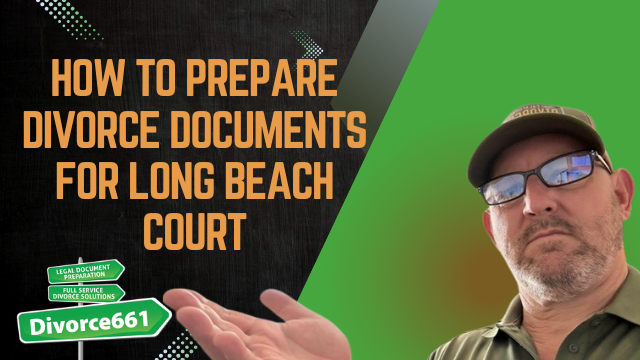How to Prepare Divorce Documents for Long Beach Court
Filing for divorce in Long Beach means dealing with the Los Angeles County Superior Court and its strict paperwork and e-filing requirements. Small mistakes or missing attachments can lead to rejections, delays, and extra stress. This guide walks through the paperwork you need, how to serve your spouse, mandatory financial disclosures, and practical tips to get your case accepted the first time.
The Long Beach divorce process at a glance
Understanding the sequence of steps helps prevent common missteps. The typical flow is:
- Prepare and file the initial forms with the Los Angeles County Superior Court using the county’s e-filing system.
- Serve your spouse correctly and file proof of service or a signed acknowledgement.
- Exchange mandatory financial disclosures.
- Negotiate and draft a Marital Settlement Agreement if the parties are in agreement.
- Prepare the judgment packet and any required attachments, then submit for court approval.
Initial forms you must file
Start with the core documents. Make sure each form is completed accurately and formatted according to court rules.
- Petition (FL-100) — Begins the case and states the relief requested.
- Summons (FL-110) — Notifies the respondent of the case and any restrictions (like temporary restraining orders).
- UCCJEA / Child Custody Jurisdiction (FL-105) — Required when there are minor children to establish jurisdiction and provide information about the children’s residences.
Filing these correctly is the foundation. Missing or incomplete information here can stop everything before it starts.
How to serve your spouse
Service must follow California rules. Two common methods are:
- Personal service — A third party (not you) hands the documents to your spouse and completes a Proof of Service form.
- Notice and Acknowledgement of Receipt (FL-117) — If your spouse signs this form, they acknowledge receipt and you can file it in lieu of personal service.
File proof of service or the signed acknowledgement promptly. Improper service is one of the most frequent reasons courts delay processing.
Mandatory financial disclosures
Even when spouses agree, exchange of financial information is required. These disclosures give the court and both parties a complete picture of assets, debts, and income.
- Preliminary Declaration of Disclosure — The formal process of sharing documents and statements about finances.
- Schedule of Assets and Debts (FL-142) — Lists property, bank accounts, retirement accounts, loans, and other liabilities.
- Income and Expense Declaration (FL-150) — Details current income, employment, monthly expenses, and deductions.
Exchange the completed disclosures and keep copies. Failing to exchange or provide accurate disclosures can lead to sanctions or reversal of agreements later.
Marital Settlement Agreement and the judgment packet
If the case is uncontested, a properly drafted Marital Settlement Agreement explains how assets, debts, support, custody, and visitation will be handled. This agreement is attached to the final paperwork the court signs.
The judgment package typically includes the Judgment (FL-180) and any attachments required by the court. Missing attachments in the judgment packet are a common and costly error. Confirm the court’s checklist before submitting to avoid rejections.
Common paperwork mistakes and how to avoid them
- Missing attachments — Double-check the judgment packet and attachment lists. One missing document can cause a rejection.
- Incorrect or outdated form versions — Always use the current California Judicial Council forms and verify form codes (for example, FL-100, FL-110, FL-105, FL-142, FL-150, FL-180).
- Improper service — Use personal service or a properly signed Notice and Acknowledgement of Receipt (FL-117).
- Unsigned forms or missing signatures — Ensure every required signature and date is present and legible.
- Formatting and e-filing errors — Los Angeles County requires specific formatting for electronic filings; follow e-filing rules exactly.
- Not exchanging disclosures — Even in amicable cases, exchanging financial disclosures is mandatory.
A Long Beach client filed their own paperwork but missed one required attachment in the judgment packet. The court rejected the submission twice. After the missing documents were added and the packet resubmitted correctly, the divorce was approved in under a week.
Practical checklist to reduce the chance of rejection
- Confirm the current versions of all required forms: FL-100, FL-110, FL-105, FL-142, FL-150, FL-180.
- Complete every field accurately and check for consistency across forms.
- Serve the respondent properly and file proof of service or FL-117.
- Prepare and exchange complete financial disclosures before filing settlement documents.
- Include every required attachment listed in the court’s checklist for the judgment packet.
- Verify e-filing formatting requirements for Los Angeles County Superior Court.
Need help preparing documents for Long Beach Court?
Preparing and filing divorce paperwork correctly the first time saves time, money, and stress. If you prefer professional help, consider a service that focuses on California family law forms and Los Angeles County e-filing procedures. For a quick next step, have your form list ready, confirm whether children are involved, and gather recent pay stubs and account statements to speed the process.
For more information or assistance, visit divorce661.com or consult a family law professional familiar with Los Angeles County procedures.









